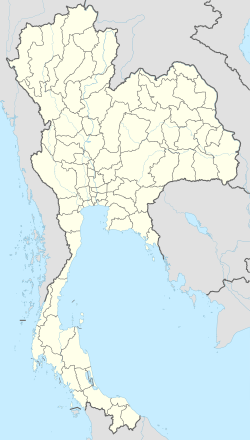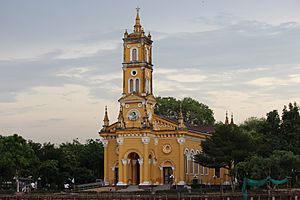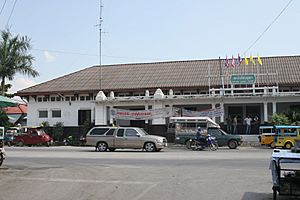Phra Nakhon Si Ayutthaya (city) facts for kids
Quick facts for kids
Phra Nakhon Si Ayutthaya
พระนครศรีอยุธยา
Principality of Ayutthaya
|
||
|---|---|---|
|
City Municipality
|
||
| City of Phra Nakhon Si Ayutthaya เทศบาลนครพระนครศรีอยุธยา |
||
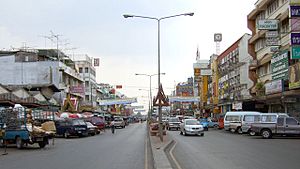 |
||
|
||
| Country | ||
| Province | Phra Nakhon Si Ayutthaya | |
| District | Phra Nakhon Si Ayutthaya | |
| Named for | Ayodhya, Uttar Pradesh, India | |
| Government | ||
| • Type | City Municipality | |
| Area | ||
| • Total | 14.84 km2 (5.73 sq mi) | |
| Population
(2020)
|
||
| • Total | 50,830 | |
| • Density | 3,425.2/km2 (8,871/sq mi) | |
| Registered residents only | ||
| Time zone | UTC+7 (ICT) | |
| Postcode |
13xxx
|
|
| Area code | (+66) 35 | |
| Website | ayutthayacity.go.th/ | |
Phra Nakhon Si Ayutthaya, often called simply Ayutthaya, is the capital city of Phra Nakhon Si Ayutthaya province in Thailand. It was once the capital of the powerful Ayutthaya Kingdom. The city is built on an island where the Chao Phraya and Pa Sak rivers meet. It is also the birthplace of King Rama I, who founded Bangkok. Today, the old city's ruins are protected in the Ayutthaya Historical Park.
Contents
What's in a Name?
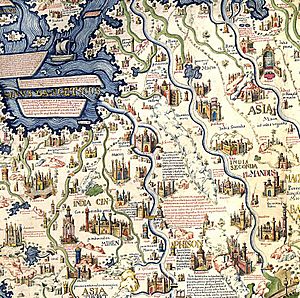
The name Ayutthaya comes from a Sanskrit word, Ayodhya. This name is also found in the Thai national story, Ramakien. The word phra means something royal or sacred. The word nakhon means an important or capital city. So, the full name means something like "Holy Capital City of Ayutthaya."
A Look Back: Ayutthaya's History

Even before its official start date, Ayutthaya was a busy port town in the late 1200s. King Mongkut wrote in the 1800s that Ayutthaya was built on the ruins of an older city called Lawek, which belonged to Cambodia. This is supported by Wat Phanan Choeng, a temple built in 1324, which was 27 years before Ayutthaya was officially founded.
Ayutthaya was officially founded in 1351 by King U Thong. He moved there to escape a smallpox outbreak in Lopburi. He made it the capital of his kingdom, which we now call the Ayutthaya Kingdom or Siam. Ayutthaya became the second capital of Siam, after Sukhothai.
By the year 1600, Ayutthaya had about 300,000 people. Around 1700, its population might have reached 1,000,000. This made it one of the largest cities in the world at that time! People sometimes called it the "Venice of the East" because of its many canals.
In 1767, the city was destroyed by the Burmese army. This led to the end of the Ayutthaya Kingdom. The beautiful ruins of the old city are now part of the Ayutthaya historical park. This park is a UNESCO World Heritage Site, meaning it's very important to the world. The ruins, with their tall towers and huge monasteries, show how grand the city once was. The modern city of Ayutthaya was built a few kilometers to the east.
How Many People Live Here?
Since 2005, the number of people living in Ayutthaya has slowly gone down.
| Estimation date | 31 Dec 2005 | 31 Dec 2010 | 31 Dec 2015 | 31 Dec 2019 |
|---|---|---|---|---|
| Population | 55,097 | 54,190 | 52,940 | 50,830 |
Where is Ayutthaya?
The city is about 64 kilometers (40 miles) north of Bangkok.
Weather in Ayutthaya
Ayutthaya has three main seasons:
- Hot Season: March to May
- Rainy season: June to October
- Cool season: November to February
| Climate data for Ayutthaya | |||||||||||||
|---|---|---|---|---|---|---|---|---|---|---|---|---|---|
| Month | Jan | Feb | Mar | Apr | May | Jun | Jul | Aug | Sep | Oct | Nov | Dec | Year |
| Mean daily maximum °C (°F) | 31.6 (88.9) |
34.0 (93.2) |
36.7 (98.1) |
37.4 (99.3) |
36.8 (98.2) |
34.2 (93.6) |
33.8 (92.8) |
32.8 (91.0) |
32.3 (90.1) |
32.3 (90.1) |
32.0 (89.6) |
30.9 (87.6) |
33.7 (92.7) |
| Mean daily minimum °C (°F) | 18.4 (65.1) |
20.2 (68.4) |
24.4 (75.9) |
25.6 (78.1) |
26.4 (79.5) |
26.3 (79.3) |
25.5 (77.9) |
24.8 (76.6) |
24.4 (75.9) |
23.5 (74.3) |
21.6 (70.9) |
19.4 (66.9) |
23.4 (74.1) |
| Average rainfall mm (inches) | 2.4 (0.09) |
18.8 (0.74) |
43.5 (1.71) |
67.9 (2.67) |
208.0 (8.19) |
223.0 (8.78) |
180.8 (7.12) |
260.0 (10.24) |
213.9 (8.42) |
167.6 (6.60) |
37.1 (1.46) |
0.8 (0.03) |
1,423.8 (56.05) |
| Average rainy days | 0 | 1 | 4 | 6 | 15 | 16 | 17 | 19 | 17 | 12 | 3 | 1 | 111 |
| Source: Thai Meteorological Department | |||||||||||||
The city is located where the Chao Phraya, Lopburi, and Pa Sak rivers meet. The old city is on an island. This island is surrounded by the Chao Phraya River on the west and south, the Pa Sak River on the east, and the Klong Muang canal on the north.
Places to See in Ayutthaya
Famous Temples and Historical Sites
| Name | Picture | Built | Sponsor(s) | Notes |
|---|---|---|---|---|
| Wat Yai Chai Mongkhon | 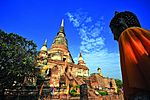 |
1357 | King Ramathibodi I | One of the most famous temples in Ayutthaya. |
| Wat Mahathat |  |
1374 | King Borommaracha I | Famous for the Buddha head in tree roots. |
| Wat Chai Watthanaram |  |
1630 | King Prasat Thong | A very beautiful temple, especially at sunset. |
| Wat Phanan Choeng | 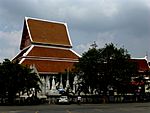 |
1324 | Built before Ayutthaya was officially founded. | |
| Wat Phra Si Sanphet | 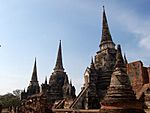 |
1350 | King Ramathibodi I | Was the royal temple inside the palace grounds. |
| Wihan Phra Mongkhon Bophit | 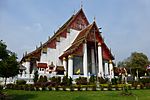 |
c. 1637 (restored many times) | King Chairacha King Borommakot |
Home to a large bronze Buddha statue. |
| Wat Na Phra Men | 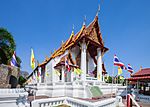 |
1503 | King Ramathibodi II | One of the few temples that survived the Burmese attack. |
| Wat Ratchaburana | 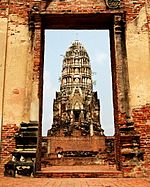 |
1424 | King Borommarachathirat II | Known for its crypt with many treasures. |
| Wat Lokaya Sutharam |  |
1452 | King Intharacha | Features a large reclining Buddha statue. |
| Wat Phra Ram | 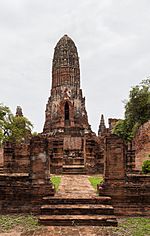 |
1369 | King Ramesuan | Located near the royal palace. |
| Wat Phutthaisawan | 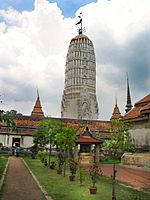 |
Before 1350 | King Ramathibodi I | Another temple built before the city's official founding. |
| Chedi Phukhao Thong | 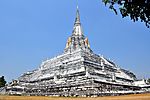 |
c. 1569, 1587 (rebuilt in 1744) | King (then-Prince) Naresuan King Borommakot |
A large white chedi (stupa) built to celebrate a victory. |
| Wat Thammikarat | 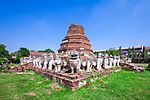 |
Before 1350 | King of Lavo | An ancient temple with lion statues. |
Museums to Explore
- Ayutthaya Historical Study Centre: Learn more about the city's past.
- Chao Sam Phraya National Museum: See amazing items found from the ruins of Wat Racha Burana and Wat Maha That temples.
Other Fun Places to Visit
- Wang Luang: The old Royal Palace grounds.
- Wat Suwan Dararam: A beautiful temple with unique architecture.
- St. Joseph's Church: A historic church showing the city's diverse past.
- Baan Hollanda: A Dutch village museum, showing the history of Dutch traders in Ayutthaya.
Ayutthaya Night Market
The night market is a great place to shop and eat! You can find lots of food, clothes, and handmade crafts. Try traditional Thai dishes like pad Thai or mango sticky rice. There are also many souvenirs like handmade bags and jewelry. The market is lively with music, street performers, and colorful lights.
The Floating Market of Ayutthaya
There's a special floating market in Ayutthaya called Klong Sabua. It's very popular with Thai visitors. The best part is the Water Theatre, which is said to be the only one of its kind in Thailand. It has live shows of Thai folk tales and musicals.
Getting to Ayutthaya
You can reach Ayutthaya by plane or train.
By Air
The closest airport is Don Mueang International Airport in Bangkok. This airport is a hub for many budget airlines. You can walk from Terminal 1 to the Don Muang Train Station, where trains to Ayutthaya often pass through.
By Train
Trains to Ayutthaya leave Bangkok's Hua Lamphong Station almost every hour. They run from 4:20 AM to 10:00 PM. A 3rd class ticket costs about 20 baht, and the trip takes about 1.5 hours. You can get train schedules at the information booth in Hua Lamphong Station.
Ayutthaya in Pop Culture
Ayutthaya has appeared in many games and movies!
- A town called "Ayothaya" is in the computer game Ragnarok Online.
- Ayutthaya is a stage in the game Soul Calibur II.
- Temples from Ayutthaya, like Wat Phra Si Sanphet and Wat Ratchaburana, appear in Street Fighter II, Kickboxer, Mortal Kombat, Mortal Kombat Annihilation, and Mortal Kombat Conquest.
- The famous lying Buddha statue from Ayutthaya's ruins is in Sagat's stage in most Street Fighter games.
- It was featured in the 2005 movie "The King Maker".
- The destruction of the Japanese quarter in Ayutthaya in 1630 is part of a story in the 1632 series book Ring of Fire III.
- In the 2010 Nintendo DS game Golden Sun: Dark Dawn, the city of 'Ayuthay' is based on Thai culture and architecture.
- A map named "Ayutthaya" is in the video game Overwatch.
- Ayutthaya was a non-playable city-state in the 2016 video game Civilization VI. It helped civilizations allied with it earn more culture points.
Images for kids
See also
 In Spanish: Ayutthaya para niños
In Spanish: Ayutthaya para niños



